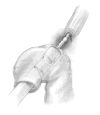Outcomes after minimally invasive esophagectomy: review of over 1000 patients
- PMID: 22668811
- PMCID: PMC4103614
- DOI: 10.1097/SLA.0b013e3182590603
Outcomes after minimally invasive esophagectomy: review of over 1000 patients
Abstract
Background: Esophagectomy is a complex operation and is associated with significant morbidity and mortality. In an attempt to lower morbidity, we have adopted a minimally invasive approach to esophagectomy.
Objectives: Our primary objective was to evaluate the outcomes of minimally invasive esophagectomy (MIE) in a large group of patients. Our secondary objective was to compare the modified McKeown minimally invasive approach (videothoracoscopic surgery, laparoscopy, neck anastomosis [MIE-neck]) with our current approach, a modified Ivor Lewis approach (laparoscopy, videothoracoscopic surgery, chest anastomosis [MIE-chest]).
Methods: We reviewed 1033 consecutive patients undergoing MIE. Elective operation was performed on 1011 patients; 22 patients with nonelective operations were excluded. Patients were stratified by surgical approach and perioperative outcomes analyzed. The primary endpoint studied was 30-day mortality.
Results: The MIE-neck was performed in 481 (48%) and MIE-Ivor Lewis in 530 (52%). Patients undergoing MIE-Ivor Lewis were operated in the current era. The median number of lymph nodes resected was 21. The operative mortality was 1.68%. Median length of stay (8 days) and ICU stay (2 days) were similar between the 2 approaches. Mortality rate was 0.9%, and recurrent nerve injury was less frequent in the Ivor Lewis MIE group (P < 0.001).
Conclusions: MIE in our center resulted in acceptable lymph node resection, postoperative outcomes, and low mortality using either an MIE-neck or an MIE-chest approach. The MIE Ivor Lewis approach was associated with reduced recurrent laryngeal nerve injury and mortality of 0.9% and is now our preferred approach. Minimally invasive esophagectomy can be performed safely, with good results in an experienced center.
Conflict of interest statement
Disclosure: The authors declare no conflicts of interest.
Figures




Comment in
-
Poorer Survival for Stage IIa Patients After Minimally Invasive Esophagectomy.Ann Surg. 2015 Aug;262(2):e45. doi: 10.1097/SLA.0000000000000532. Ann Surg. 2015. PMID: 24670854 No abstract available.
-
Reply to Letter: "Poorer Survival for Stage IIa Patients After Minimally Invasive Esophagectomy".Ann Surg. 2015 Aug;262(2):e45-7. doi: 10.1097/SLA.0000000000000864. Ann Surg. 2015. PMID: 25590498 No abstract available.
References
-
- Enzinger PC, Mayer RJ. Esophageal cancer. N Engl J Med. 2003;349:2241–2252. - PubMed
-
- Pennathur A, Luketich JD. Resection for esophageal cancer: strategies for optimal management. Ann Thorac Surg. 2008;85:S751–S756. - PubMed
-
- Birkmeyer JD, Siewers AE, Finlayson EVA, et al. Hospital volume and surgical mortality in the United States. N Engl J Med. 2002;346:1128–1137. - PubMed
MeSH terms
Grants and funding
LinkOut - more resources
Full Text Sources
Medical

